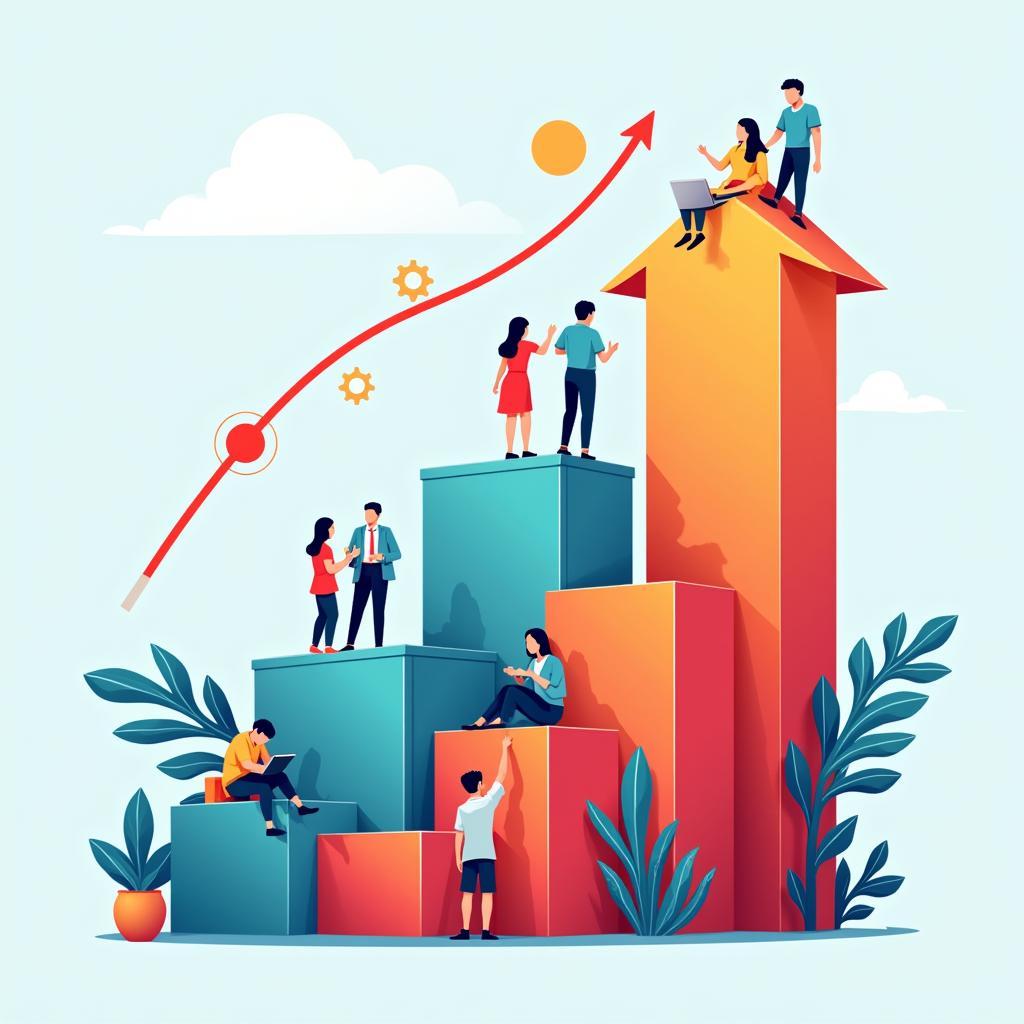“Ano Ang Asean Integration?” This question, frequently posed in Filipino, translates to “What is ASEAN integration?” in English. It reflects a growing curiosity about the ongoing efforts to bring the ten Southeast Asian nations of ASEAN closer together. This pursuit of unity aims to foster a region where economies thrive, cultures intertwine, and people connect seamlessly across borders.
 ASEAN Economic Growth
ASEAN Economic Growth
Delving Deeper: What Does ASEAN Integration Mean?
ASEAN integration represents a continuous process of enhancing cooperation and connectivity among the member states: Brunei, Cambodia, Indonesia, Laos, Malaysia, Myanmar, the Philippines, Singapore, Thailand, and Vietnam. This integration manifests across three key pillars:
-
Political-Security Community: Strengthening peace, security, and political cooperation. This involves addressing regional challenges collaboratively, upholding international law, and promoting dialogue in conflict resolution.
-
Economic Community: Envisioning a single market and production base with free flow of goods, services, investment, and skilled labor. This economic integration aims to boost ASEAN’s competitiveness on the global stage.
-
Socio-Cultural Community: Fostering a shared ASEAN identity and promoting cultural exchange. This encompasses collaboration in education, healthcare, environmental protection, and social development to improve the lives of ASEAN citizens.
The Why Behind the What: Benefits of ASEAN Integration
The pursuit of ASEAN integration is driven by a desire to reap numerous benefits:
-
Accelerated Economic Growth: By dismantling trade barriers and facilitating the movement of goods, services, and investments, ASEAN aims to create a more dynamic and prosperous region. This translates to more job opportunities, higher incomes, and improved living standards for its citizens.
-
Enhanced Regional Security: Facing common challenges such as transnational crime, terrorism, and natural disasters, ASEAN recognizes the importance of collective action. Integration facilitates greater cooperation in areas of defense, intelligence sharing, and disaster response.
-
Increased Global Influence: As a unified bloc, ASEAN commands a stronger voice on the international stage. Integration amplifies the region’s bargaining power in trade negotiations and its influence in shaping global issues.
-
Preservation of Cultural Heritage: Southeast Asia boasts a rich tapestry of cultures and traditions. ASEAN integration strives to preserve this heritage while fostering understanding and appreciation among its diverse population.
The ASEAN Journey: Milestones and Aspirations
The journey towards ASEAN integration is marked by significant milestones:
-
1967: ASEAN is established with the signing of the Bangkok Declaration.
-
1992: The ASEAN Free Trade Area (AFTA) is launched to eliminate tariffs and promote intra-ASEAN trade.
-
2007: The ASEAN Charter is adopted, providing a legal framework and institutional structure for deeper integration.
-
2015: The ASEAN Economic Community (AEC) is formally established, marking a significant step towards economic integration.
Looking ahead, ASEAN has set its sights on realizing the ASEAN Community Vision 2025, which outlines a roadmap for a more integrated, prosperous, and peaceful region.
ano ang asean integration tagalog
ASEAN Integration in Action: Real-world Examples
The impact of ASEAN integration is evident in various aspects of daily life:
-
Travel and Tourism: Citizens of ASEAN member states enjoy visa-free travel within the region, boosting tourism and fostering people-to-people connections.
-
Education and Employment: Students have access to wider educational opportunities through scholarships and exchange programs. Skilled professionals benefit from mutual recognition agreements that facilitate cross-border employment.
-
Infrastructure Development: ASEAN is investing heavily in infrastructure projects, such as highways, railways, and ports, to improve connectivity and facilitate trade.
-
Disaster Response: ASEAN member states collaborate closely in times of natural disasters, sharing resources and expertise to provide humanitarian assistance.
The Road Ahead: Challenges and Opportunities
While ASEAN integration offers immense potential, the journey is not without its challenges:
-
Development Gap: Significant economic disparities exist between member states, requiring inclusive policies to ensure that all benefit from integration.
-
Political and Social Diversity: Navigating the diverse political systems, social values, and cultural norms within ASEAN requires sensitivity and a commitment to dialogue.
-
Non-Traditional Security Threats: Addressing transnational challenges like cybercrime, climate change, and pandemics demands coordinated efforts and regional solidarity.
Despite these challenges, ASEAN integration presents an opportunity to create a more prosperous, secure, and interconnected Southeast Asia.
Conclusion: A Shared Vision for a Brighter Future
“Ano ang ASEAN integration?” It’s not merely a question but a vision—a vision of a unified Southeast Asia where people, goods, and ideas flow freely. While the path to full integration may be long and complex, the commitment of ASEAN member states to this shared vision promises a brighter future for the region and its people.
ano ang asean economic community
Frequently Asked Questions
1. What is the main goal of ASEAN integration?
The primary objective is to enhance regional cooperation across various sectors – political, economic, and socio-cultural – to promote peace, stability, and prosperity for all ASEAN member states.
2. How does ASEAN integration benefit businesses?
Integration creates a larger market with reduced trade barriers, facilitating business expansion, investment opportunities, and access to a wider pool of talent and resources.
3. What are some of the challenges faced by ASEAN in achieving integration?
Key challenges include addressing the development gap between member states, navigating political and social diversity, and tackling non-traditional security threats collaboratively.
4. How can I stay updated on ASEAN integration developments?
You can visit the official ASEAN website and follow reputable news sources covering Southeast Asian affairs for the latest news and analysis.
5. What role can individuals play in supporting ASEAN integration?
By embracing cultural exchange, supporting regional businesses, and staying informed about ASEAN initiatives, individuals contribute to fostering a stronger sense of community.
For any ASEAN-related questions or inquiries, reach out to us!
Phone: 0369020373
Email: [email protected]
Address: Thon Ngoc Lien, Hiep Hoa, Bac Giang, Vietnam.
Our dedicated customer support team is available 24/7 to assist you!

